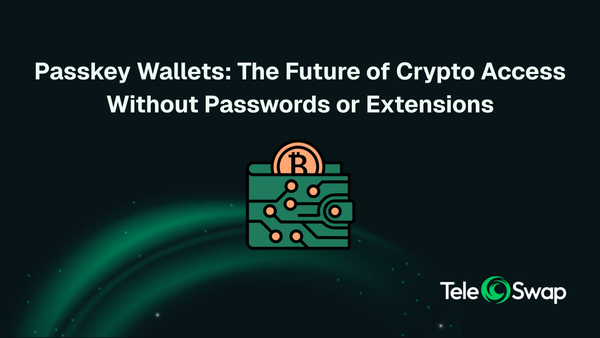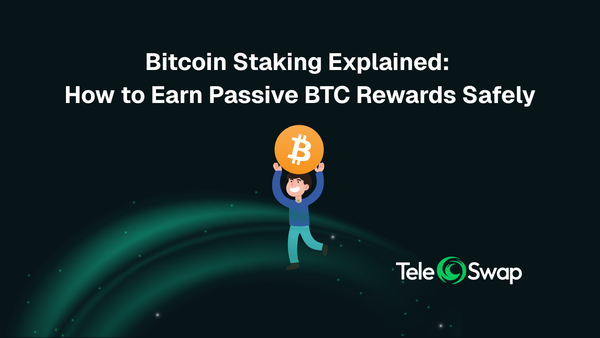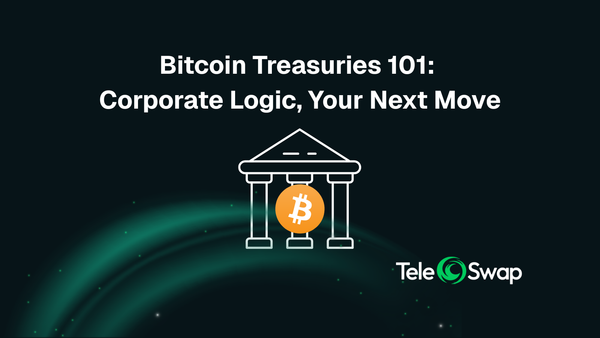How to Earn Passive Income on Your BTC with TeleSwap (2025 Guide)

I. Introduction: Unlocking Bitcoin's Passive Income Potential in 2025
The cryptocurrency landscape is undergoing a significant transformation, with Bitcoin, traditionally revered as a robust store of value, increasingly being explored for its potential to generate yield within the burgeoning decentralized finance (DeFi) ecosystem. This evolution signifies a maturation of the crypto space, moving beyond simple holding to active participation in innovative financial protocols. The growing interest in generating passive income from Bitcoin underscores a fundamental shift in how this foundational cryptocurrency is perceived and utilized. This evolving demand is a driving force behind the development of interoperability solutions like TeleSwap, which aim to bridge Bitcoin's inherent characteristics with the utility and yield-generating capabilities found in decentralized finance. This trend indicates a growing sophistication among crypto investors seeking to maximize their asset utility.
For Bitcoin holders, generating passive income unlocks new revenue streams that extend beyond mere price appreciation, offering a means to diversify their crypto portfolio's income. Passive income, defined as earnings from investments requiring minimal active involvement, allows capital to work for its owner.1 This approach can provide steady earnings while assets are held long-term, potentially boosting overall returns, diversifying income sources, and even reducing portfolio risk in volatile markets.
Within this context, TeleSwap emerges as a notable innovation. It is positioned as a fully decentralized cross-chain settlement protocol specifically designed for Bitcoin, aiming to overcome the limitations and risks associated with existing wrapped BTC solutions. TeleSwap’s core functionality involves enabling users to transfer and exchange assets between Bitcoin and EVM-compatible chains.3 The explicit emphasis on being "fully decentralized" and "trustless" in TeleSwap's design is a direct response to historical failures and inherent risks associated with centralized entities in the crypto space. Events such as the FTX collapse and the bankruptcies of lending platforms like BlockFi and Celsius have highlighted the vulnerabilities of relying on centralized custodians. By prioritizing user control over funds and a permissionless architecture, TeleSwap presents a more secure and philosophically aligned alternative for Bitcoin holders who value decentralization and seek to minimize counterparty risk.
II. Understanding Passive Income Strategies for Bitcoin Holders
Passive income in the cryptocurrency world refers to earning returns on digital assets with minimal active involvement, distinct from active trading or speculative activities.1 Unlike traditional financial methods, such as earning interest from bank accounts or dividends from stocks, crypto passive income leverages the unique properties of decentralized finance (DeFi) and blockchain technology, often leading to potentially higher returns.
Overview of DeFi Passive Income Methods
Several methods allow crypto holders to generate passive income within the DeFi ecosystem:
- Lending: This strategy involves depositing crypto assets into decentralized lending protocols, which then lend these assets to borrowers. In return, the depositors earn interest on their supplied assets.6 Protocols such as Aave and Compound are prominent examples of platforms that facilitate this.6 While decentralized lending offers a low barrier to entry and the potential for compound interest, it is crucial to distinguish it from centralized lending platforms. The historical failures of centralized entities like Celsius and BlockFi, which faced bankruptcy, underscore the significant "platform risk" and "low protections" often found in unregulated environments.4 Such events can lead to users losing access to their holdings, and funds can become illiquid if locked for extended periods.4 The critical importance of decentralized lending protocols when seeking passive income is to mitigate counterparty risk, aligning with the core principles of DeFi and setting the stage for why TeleSwap's decentralized nature is a key differentiator.
- Yield Farming: This more advanced DeFi strategy involves providing liquidity to decentralized exchanges (DEXs) or lending protocols. Participants earn rewards typically in the form of transaction fees and/or governance tokens.7 These protocols often utilize Automated Market Makers (AMMs), such as Uniswap and SushiSwap, which operate liquidity pools for token swaps without relying on traditional order books.7 While yield farming presents compelling opportunities for rewards, it also carries significant risks, including scams, market volatility, and impermanent loss.8
- Staking: This method involves locking crypto assets into a Proof-of-Stake (PoS) blockchain network to support its operational security and transaction validation. In return, participants earn rewards. It is important to note that Bitcoin operates on a Proof-of-Work (PoW) consensus mechanism, which fundamentally differs from PoS. Therefore, native BTC cannot be directly staked to earn rewards in the same way PoS cryptocurrencies like Ethereum (post-merge), Cardano, or Solana can. This inherent limitation of native Bitcoin directly drives the demand for wrapped BTC solutions like TeleBTC, as they enable Bitcoin holders to access PoS-based DeFi yield generation, highlighting the core problem that TeleSwap is designed to solve.
Traditional BTC Passive Income Avenues
While DeFi-native strategies are a primary focus, other existing methods for earning passive income with Bitcoin are also available:
- ETFs and Index Funds: Crypto index funds and Exchange-Traded Funds (ETFs), such as ProShares Bitcoin Strategy ETF (BITO) and Purpose Bitcoin Yield ETF (BTCY), offer exposure to Bitcoin and can generate yield, often through Bitcoin futures contracts or covered call strategies.
- Cloud Mining: Platforms like DOT Miners allow users to earn passive income from Bitcoin mining without the need for physical hardware or extensive technical expertise. These services often emphasize regulatory compliance and the use of renewable energy sources.
- Learn & Earn Programs: Various platforms, including Binance, Coinbase, and Revolut, offer "Learn & Earn" programs. These initiatives provide small crypto rewards to users who complete educational modules on cryptocurrency topics, serving as an accessible entry point for new users.
The existence of these "traditional" BTC passive income avenues indicates a widespread market desire for Bitcoin yield. However, these methods often come with their own set of considerations, such as reliance on the ETF issuer or cloud mining provider, or specific operational complexities like covered calls potentially capping upside potential.TeleSwap's decentralized approach offers a distinct alternative for users who prioritize minimizing counterparty risk while still seeking to earn yield, providing a different risk-reward profile compared to more centralized options.
III. Bridging Bitcoin to DeFi: The Role of Wrapped BTC
The Challenge: Bitcoin's Limited Interoperability
Bitcoin's native blockchain, designed primarily for secure peer-to-peer transactions, inherently lacks native smart contract functionality. This fundamental design choice makes it incompatible with most smart-contract-enabled DeFi ecosystems, such as Ethereum, Polygon, and BNB Chain. This "language barrier" prevents native BTC from directly participating in the vast array of DeFi protocols that operate on these networks. As a result, it is not possible to directly transfer native Bitcoin to an Ethereum wallet or other EVM-compatible wallets.13 This interoperability challenge is a key hurdle for Bitcoin holders seeking to leverage their assets in DeFi.
Wrapped Bitcoin (WBTC): Functionality, Benefits, and Centralized Risks
To bridge this gap, Wrapped Bitcoin (WBTC) was introduced. WBTC is an ERC-20 token built on the Ethereum blockchain, designed to represent Bitcoin. It is pegged 1:1 to the value of BTC, allowing Bitcoin's immense liquidity and value to be utilized within the Ethereum-based DeFi ecosystem.13 WBTC enables Bitcoin enthusiasts to engage with DeFi protocols, NFTs, and other decentralized applications on Ethereum.
The benefits of WBTC are significant. It substantially enhances liquidity within the DeFi space, allowing Bitcoin's value to flow into and support various financial applications, from lending platforms to decentralized exchanges. Furthermore, WBTC leverages Ethereum's faster block times, leading to quicker transaction confirmations compared to traditional Bitcoin transactions, which can be advantageous for active DeFi participation. Crucially, WBTC provides a pathway for interoperability between the otherwise isolated Bitcoin and Ethereum networks.
However, a significant drawback of WBTC is its reliance on a centralized custodian, typically BitGo, to hold the actual Bitcoin reserves that back the wrapped tokens. This introduces a single point of failure and inherent counterparty risk. Centralized lending platforms, for instance, involve custodial risk, where users must trust the platform to remain solvent and secure. The collapse of firms like Celsius and BlockFi has starkly highlighted this vulnerability, demonstrating that if a centralized entity holding wrapped BTC assets faces bankruptcy or a hack, the wrapped tokens could become worthless, leading to a total loss of users' Bitcoin. This dependence on a trusted third party fundamentally conflicts with Bitcoin's peer-to-peer, decentralized ethos, which aims to remove centralized authority. The inherent contradiction of using a centralized wrapped asset like WBTC to access decentralized finance creates a "centralization paradox" that conflicts with the core principles of DeFi, which emphasize trust-minimization and user control. This is precisely the problem TeleSwap aims to resolve, making its truly decentralized bridge a compelling alternative for users prioritizing trust minimization.
TeleSwap's Innovation: TeleBTC – A Truly Decentralized Solution
TeleSwap addresses the centralization concerns of existing wrapped BTC solutions by introducing TeleBTC, a trustless wrapped BTC built on the TeleportDAO bridge. TeleSwap's ambition is to function as a fully decentralized Bitcoin DEX, allowing seamless and permissionless interaction between Bitcoin and EVM chains without involving any centralized entity.
Mechanism: Collateralization, Liquidation, and Trustless Minting/Burning
TeleBTC employs a unique and robust security mechanism to ensure its decentralized nature and maintain its 1:1 peg to native Bitcoin. "Lockers," who act as decentralized custodians, are required to lock a significant amount of collateral on Polygon, valued at more than 2 BTC, to mint TeleBTC. This over-collateralization provides a strong buffer against malicious activity and ensures the wrapped asset is tightly pegged to BTC's price.
A crucial security feature is the liquidation mechanism. If a Locker attempts to steal users' BTCs, or if their collateral value drops below the minted TeleBTC due to price fluctuations, anyone can report this behavior to the Polygon smart contract.19 The contract then automatically slashes the Locker's collateral, ensuring accountability and disincentivizing theft or irresponsible behavior. This mechanism ensures sufficient collateralization to maintain the 1:1 peg of TeleBTC to native BTC.
Users initiate the minting of TeleBTC by sending native BTC to a Locker's Bitcoin address. They then submit cryptographic proof of this transaction to the Polygon smart contract, which validates the proof using the TeleportDAO bridge and mints TeleBTC for them. Conversely, burning TeleBTC allows users to redeem native BTC by sending a burn request to the Polygon contract, which assigns a Locker to send the BTC back to the user. This entire process is designed to be trustless, meaning no single entity can prevent a user from minting or burning TeleBTC, ensuring its permissionless and censorship-resistant nature.
The TeleportDAO Bridge: Enabling Seamless Cross-Chain Interaction
TeleportDAO serves as the underlying light-client interoperability protocol that directly connects blockchains. This enables the Polygon smart contract to securely monitor and read data from the Bitcoin blockchain, which is essential for verifying Bitcoin transactions and managing the Lockers' collateral.TeleSwap prioritizes high-speed settlement, aiming for users to receive wrapped BTC on other chains in less than a minute. This represents a significant improvement compared to Bitcoin's inherently slower native confirmation times, which can often exceed an hour.3
TeleSwap's sophisticated design, particularly its over-collateralization and liquidation mechanism, directly addresses and mitigates the "systemic financial risks" and "infinite mint attacks" that have plagued other cross-chain bridge designs. The history of bridge hacks, including the almost $600 million loss on the Axie Infinity Ronin Bridge, highlights the severe vulnerabilities in this critical infrastructure. By implementing an advanced security architecture that ensures assets are always over-collateralized and that malicious behavior is penalized, TeleSwap aims to achieve a higher degree of trust minimization. This robust design is a critical factor for attracting both retail and institutional adoption, as it builds confidence in the security of cross-chain transfers, fostering large-scale DeFi participation for Bitcoin holders.
Understanding Cross-Chain Bridge Security and Risks
Cross-chain bridges are indispensable for blockchain interoperability, enabling seamless asset and data transfers between distinct blockchain ecosystems. Without them, blockchain networks remain isolated, limiting how users and assets move. However, despite sophisticated designs, these bridges remain significant targets for cyberattacks, leading to substantial financial losses across the industry.
Key risks associated with cross-chain bridges include:
- Smart Contract Risks: Bugs and vulnerabilities in the smart contracts that govern bridge operations can expose users' assets to exploits. History provides numerous examples of DeFi platforms suffering significant smart contract exploits, resulting in the loss of millions of dollars.
- Systemic Financial Risks: Many bridges lock tokens on a source chain and mint derivative or wrapped tokens on a destination chain. A hack of the locked tokens or an "infinite mint attack" on the wrapped tokens can make all wrapped tokens worthless, exposing entire blockchains to risk.
- Centralization Risks: Trusted (custodial) bridges require a third party to validate movements, meaning users must give up control of their assets and rely on the bridge operator's reputation. This introduces counterparty risk and a single point of failure.
- Early Stage Technology: Given that bridges are relatively new, there are many unanswered questions related to how they will perform in different market conditions.
- Liquidity and Slippage: Bridges can also face issues with fragmented liquidity across different wrapped tokens, which could affect usability or lead to significant price slippage during large trades.
The ideal bridge design aims for "trust-minimization," introducing no new trust assumptions beyond those of the underlying blockchains. This is typically achieved through the robust implementation of smart contracts and decentralized validation mechanisms. The detailed discussion of general bridge security risks, followed by a clear explanation of how TeleSwap's trustless mechanism directly addresses these vulnerabilities, is crucial for building user confidence. This approach acknowledges the user's inherent caution when moving valuable BTC assets off the native Bitcoin blockchain and positions TeleSwap as a safer alternative in a high-risk landscape, demonstrating a comprehensive understanding of potential user concerns and offering a robust solution.
IV. Earning Passive Income with TeleBTC: Practical Strategies
A. Yield Farming with TeleBTC
Yield farming is a strategy where users provide their crypto assets to liquidity pools on decentralized exchanges (DEXs) or lending protocols. These pools facilitate seamless token swaps, and in return, the liquidity providers (LPs) earn rewards.25 Most Automated Market Makers (AMMs) require LPs to supply a pair of tokens in equal dollar value amounts to maintain the pool's balance.26 When liquidity providers deposit funds, they receive a liquidity provider token (LPT) representing their portion of the pool. These LP tokens can often be further staked in other protocols to earn additional rewards, creating a compounding effect. LPs receive a proportional share of the trading fees generated by the pool, which serves as their passive income.
Step-by-Step: Providing Liquidity with TeleBTC
To begin providing liquidity with TeleBTC, certain prerequisites are necessary. Users will need a compatible non-custodial wallet, such as MetaMask, which supports EVM-compatible chains. Additionally, users will need TeleBTC (obtained via the TeleSwap protocol) paired with another asset, typically a stablecoin like USDC or a major volatile asset like ETH.
The process for providing liquidity generally involves the following steps:
- Connect Wallet: Navigate to the chosen decentralized exchange (DEX) on the appropriate network (e.g., QuickSwap on Polygon, PancakeSwap on BNB Chain). Connect the non-custodial wallet to the platform, ensuring the wallet is switched to the correct blockchain network.
- Navigate to Liquidity Section: Locate the "Earn," "Liquidity," or "Pool" tab within the DEX's interface.
- Select Token Pair: Choose the TeleBTC token and the desired paired asset (e.g., TeleBTC/USDC). It is important to confirm that both tokens are held in approximately equal dollar value.
- Choose Fee Tier (for V3 DEXs): If the DEX utilizes a V3 (concentrated liquidity) model, select an appropriate fee tier. Common tiers include 0.01% for stablecoin pairs, which exhibit low price volatility and high trading frequency, or 0.25% for moderately volatile pairs. The platform often automatically suggests the most popular tier.
- Set Price Range (for V3 DEXs like QuickSwap/PancakeSwap): This is a critical step for V3 liquidity provision. Users must define the specific lower and upper price limits within which their provided liquidity will be active and earn fees. A narrower range can significantly increase capital efficiency and potential fee earnings, but it also carries a higher risk of impermanent loss if asset prices move outside the specified range.
- Enter Amounts: Input the desired amount for one of the tokens, and the interface will automatically calculate and pre-fill the equivalent amount for the other token based on the current market ratio.
- Approve Tokens: Grant the decentralized exchange permission to interact with and use the tokens within the wallet. This is typically a one-time approval per token per platform.
- Add Liquidity: Review the transaction summary, then confirm the transaction in the wallet. A small gas fee will be incurred.
For advanced users providing liquidity via smart contracts, it is crucial to deposit tokens at the current reserve ratio to avoid immediately losing value to arbitrageurs. Using the router's
addLiquidity or addLiquidityETH methods with amount*Min parameters can help ensure this condition is met. Providing a detailed, step-by-step guide, including specific UI elements like "Earn" or "Liquidity" tabs and considerations for V3 concentrated liquidity, offers invaluable practical guidance beyond theoretical knowledge. Highlighting the importance of "price range" and "fee tier" choices for V3 DEXs demonstrates a nuanced understanding of modern LP strategies and their associated risk-reward profiles.
Key DeFi Ecosystems for TeleBTC
Given TeleSwap's design to enable Bitcoin interaction with EVM-compatible chains, Polygon and BNB Chain stand out as two of the most prominent and active EVM ecosystems with thriving DeFi activity where TeleBTC could be utilized.
- Polygon: As a leading Layer-2 scaling solution for Ethereum, Polygon offers significantly faster and lower-cost transactions compared to the Ethereum mainnet, alongside a robust ecosystem of decentralized applications. Major DeFi protocols like Aave and Curve have established a significant presence on Polygon.QuickSwap is identified as a key decentralized exchange (DEX) on the Polygon network, facilitating ERC-20 token swaps.
- BNB Chain: This high-performance blockchain ecosystem, comprising BNB Smart Chain (BSC), opBNB, and BNB Greenfield, is renowned for its speed, scalability, and affordability. It boasts a massive user base and a vibrant DeFi ecosystem that includes numerous DEXs, lending protocols, and yield farming platforms, with 187 DeFi projects listed, 37 of which are built on BSC.BTCB (Binance-pegged Bitcoin) is central to the "BTCFi" landscape on the BNB Chain, with extensive support from platforms like Venus, Radiant, Kinza, Solv, and PancakeSwap, suggesting a strong existing infrastructure for wrapped Bitcoin assets.38
By explicitly identifying Polygon and BNB Chain as key ecosystems for TeleBTC, the report anticipates the practical need to know where to implement these strategies. This demonstrates foresight and provides immediate, actionable avenues for applying the information. The selection of these chains is justified by their EVM compatibility, high transaction volume, active DeFi communities, and existing support for other wrapped BTC tokens, suggesting a fertile ground for TeleBTC liquidity.
Table 1: Top DEXs for Wrapped BTC Liquidity Pools (2025)
The following table serves as a quick, actionable reference guide for identifying potential decentralized exchange platforms where users can engage in yield farming with wrapped BTC, including potential future TeleBTC integrations. It consolidates crucial information regarding network compatibility, liquidity, and specialization, which are key decision factors for prospective liquidity providers.
Note: TeleBTC support is speculative based on TeleSwap's design to integrate with EVM-compatible chains. Volumes are indicative and subject to change.
B. Lending TeleBTC
Decentralized lending protocols allow users to deposit their crypto assets into a shared lending pool. Borrowers can then access these funds by providing over-collateralization, and the depositors earn interest on their supplied assets. These protocols often implement dynamic interest rate curves, also known as "kinked interest rate curves," which adjust based on the utilization rate of the pool. This mechanism helps balance affordable borrowing rates with attractive returns for liquidity providers, thereby maintaining protocol stability.
While specific, direct integrations for TeleBTC lending platforms are not explicitly detailed in the provided research, given TeleSwap's objective to enable Bitcoin's utility on EVM chains, TeleBTC would theoretically be compatible with major decentralized lending protocols operating on Polygon and BNB Chain. For instance, Aave on BNB Chain lists BTCB as a supported token for lending and borrowing, suggesting a strong precedent and potential avenue for other wrapped Bitcoin variants like TeleBTC.41 Furthermore, BTCB can be used as collateral to obtain loans on lending platforms such as Venus and Radiant within the BNB Chain ecosystem. The current absence of explicit mentions of TeleBTC lending platforms might suggest that its adoption in the lending sector is still nascent, or that the protocol's primary focus in its early stages is on facilitating liquidity provision and DEX functionality. This nuance is important for setting realistic expectations for the user regarding immediate lending opportunities.
V. Navigating Risks and Best Practices for TeleBTC Passive Income
Engaging in DeFi passive income strategies with TeleBTC, while potentially lucrative, involves several inherent risks that require careful consideration and risk management.
Understanding Impermanent Loss
Impermanent loss (IL) is a common risk associated with participating in DeFi liquidity pools. It occurs when the price of assets deposited into a liquidity pool changes relative to each other from the time of deposit.42 Essentially, it represents the difference between the value of assets if they had simply been held (HODL) versus their value after being staked in a liquidity pool.43 This loss is termed "impermanent" because it can be recovered if the token's price returns to its original value.43 However, the loss becomes "permanent" if liquidity is withdrawn while the price divergence persists. It is also important to note that trading fees earned by liquidity providers can often offset these losses.43
For example, consider providing liquidity to a TeleBTC/USDC pool. If a user deposits $500 worth of TeleBTC and $500 worth of USDC, totaling $1000, and the price of TeleBTC significantly increases relative to USDC, arbitrage traders will rebalance the pool by buying the relatively cheaper TeleBTC from the pool and depositing more USDC. When the user eventually withdraws their liquidity, they might receive a different ratio of TeleBTC and USDC than they initially deposited, resulting in a lower dollar value than if they had simply held both assets outside the pool.43 The greater the price change between the paired assets, the more significant the potential impermanent loss.43 While impermanent loss cannot be entirely avoided, its exposure can be reduced by using more stable tokens like stablecoins or BTC, ensuring the use of reliable Automated Market Makers, and starting with a small staking amount to diversify the portfolio.26
Smart Contract Vulnerabilities
Smart contracts are the backbone of DeFi protocols, managing funds and automating transactions.24 However, they can contain bugs or vulnerabilities that attackers may exploit, leading to catastrophic losses.20 Common smart contract risks include reentrancy attacks, integer overflow/underflow, front-running, and logic errors.44 To minimize these risks, thorough audits and formal verification of smart contracts are crucial.24 However, even audited contracts can have undiscovered vulnerabilities, making continuous vigilance essential.
Liquidity Risk
Low liquidity in a pool can lead to significant price slippage, meaning the actual execution price of a trade deviates substantially from the expected cost. This can negatively impact returns for both traders and liquidity providers, especially with large orders or in volatile markets.24 While liquidity pools aim to provide a source of liquidity where centralized exchanges might fall short, they are still susceptible to fluctuations in the amount of liquidity provided by users.
Best Practices for Minimizing Risks
To navigate the complexities and risks associated with earning passive income on BTC through TeleSwap and other DeFi protocols, adhering to best practices is crucial:
- Conduct Thorough Due Diligence: Before committing any assets, thoroughly research the chosen platform, its audit history, the team behind it, and its community reputation.
- Start Small: For those new to DeFi or a particular protocol, beginning with a modest amount of capital allows for learning the process and understanding how market shifts affect positions before committing larger sums.
- Choose Stable or Low-Volatility Pairs: To mitigate impermanent loss, consider providing liquidity to stablecoin pairs or pairs involving less volatile assets like BTC.
- Monitor Performance Regularly: Continuously assess the performance of liquidity pools and lending positions. Track LP rewards, slippage risk, and price deviations to make timely adjustments.
- Understand Lockup Periods: Be aware of any lockup periods for staked or lent assets, as these can restrict access to funds during market swings or unexpected personal needs.
- Diversify Investments: Spreading investments across different pools, protocols, or even different passive income strategies can help minimize overall risk.
- Stay Informed: The DeFi landscape is rapidly changing. Staying updated with the latest developments, algorithm updates, and security news is essential for informed decision-making.
- Prioritize Security: Always use reputable non-custodial wallets and exercise extreme caution when connecting wallets to DeFi platforms, verifying URLs to avoid phishing scams.
VI. Conclusion and Recommendations
The pursuit of passive income from Bitcoin represents a significant evolution in how this foundational digital asset is perceived and utilized. While native Bitcoin's design limits its direct participation in smart-contract-enabled DeFi, the emergence of wrapped BTC solutions has opened new avenues for yield generation. TeleSwap, with its fully decentralized and trustless TeleBTC protocol, offers a compelling alternative to existing centralized wrapped Bitcoin solutions, directly addressing the critical concerns of counterparty risk and single points of failure that have plagued the industry.
TeleSwap's innovative architecture, featuring over-collateralized Lockers and a robust liquidation mechanism monitored by the TeleportDAO bridge, aims to provide a secure and efficient pathway for Bitcoin holders to engage with EVM-compatible DeFi ecosystems like Polygon and BNB Chain. This approach is designed to mitigate the systemic financial risks and smart contract vulnerabilities that have led to substantial losses in other cross-chain bridges.
For Bitcoin holders seeking to earn passive income, TeleBTC presents a promising opportunity, particularly through yield farming in liquidity pools on prominent DEXs such as PancakeSwap, Uniswap, QuickSwap, and Curve Finance. While direct lending opportunities for TeleBTC are still emerging, the existing support for other wrapped BTC variants on major lending protocols suggests a potential future for TeleBTC in this sector.
Recommendations for BTC Holders:
- Prioritize Decentralization: When seeking passive income on Bitcoin, prioritize truly decentralized solutions like TeleSwap that minimize reliance on centralized intermediaries. This approach aligns with the core ethos of Bitcoin and DeFi, significantly reducing counterparty risk.
- Understand Wrapped BTC Mechanisms: Familiarize oneself with how wrapped Bitcoin tokens, especially decentralized ones like TeleBTC, function, including their collateralization and liquidation mechanisms. This understanding is crucial for assessing the underlying security and peg integrity.
- Conduct Thorough Due Diligence on Protocols: Before providing liquidity or lending TeleBTC, meticulously research the specific DeFi protocol. Verify its audit history, community reputation, and the experience of its development team.
- Master Impermanent Loss Mitigation: For yield farming, a deep understanding of impermanent loss is vital. Consider strategies such as providing liquidity to stablecoin pairs or utilizing concentrated liquidity features with carefully defined price ranges to manage exposure.
- Start Conservatively: Begin with a small portion of capital to gain practical experience and understand the dynamics of the chosen passive income strategy and platform before committing larger sums.
- Stay Informed on Regulatory Developments: The regulatory landscape for cryptocurrencies is dynamic. Staying updated on potential changes can help in making informed decisions about participation in DeFi activities.
The ability to earn passive income on Bitcoin through decentralized protocols like TeleSwap marks a significant step towards greater utility and integration of BTC within the broader Web3 economy. As the DeFi ecosystem continues to mature, solutions that prioritize security, decentralization, and seamless interoperability will be crucial for unlocking Bitcoin's full potential as both a store of value and a yield-generating asset.




